Boulder Ramblers is the Boulder branch of the Colorado-based Walk2Connect program. Their focus is walking while connecting with others... or... connecting with others while walking. The walk options range from half-hour strolls to more lengthy endeavors.... such as today's traverse of the Mesa Trail.

To learn more, go to walk2connect.com
The Mesa Trail runs about 6.5 miles along the foothills, connecting Chautauqua Park with Eldorado Canyon Road (the South Mesa Trailhead). There are numerous trails that branch off of it, and the trail covers many different types of micro-ecosystems... from grass prairie to pine forest. There's lots of cultural history as well.

Click for a larger view
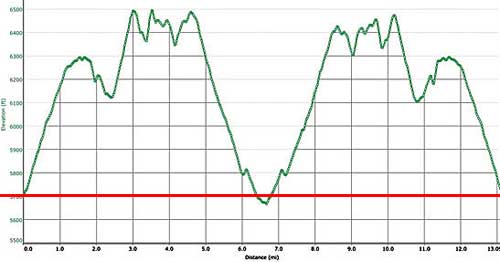
Technically, there is minimal overall elevation change from one end of the trail to the other, but that doesn't mean the trail is even remotely flat!
Rather than hike the entire trail both directions, we met at Chautauqua and carpooled to the South Mesa Trailhead, leaving a few cars in the first lot to help shuttle us back.
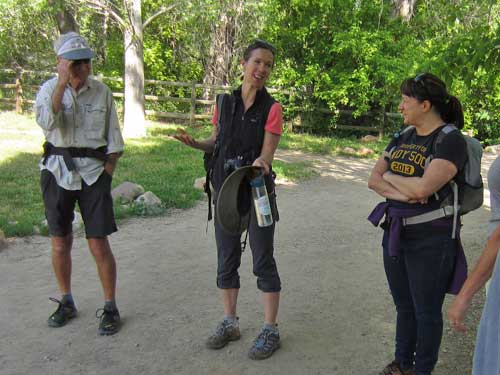
Darcy, our fabulous leader, welcomed the group.

It's important to watch where you step! The snakes often rest directly on the trail, soaking up the sun.

The weather was amazing as we set out!

This is the Doudy-Debaker-Dunn House. Andrew Doudy was the first settler in this area and built the original wooden portion of the house (now gone) sometime around 1858. In 1869, John Debaker purchased it and the surrounding land for $500. John retired in 1901 and gave the property to his daughter, Emma, and her husband, John Dunn. The Dunns raised dairy cattle and lived here until John's death in 1953.

There is still much damage from the highly destructive September 2013 flood. Trails continue to be rebuilt.

A deer waited in the thicket until everyone had passed then casually continued on its way.

Approaching our fist big hill

More evidence of the flood

The foothills are the first range you encounter heading west from the Great Plains. They're basically the first major step leading up to the high Rocky Mountains.
About 100 million years ago, all of Colorado was covered by an enormous inland sea. It sat here for about 30 million years, depositing thousands of feet of sediment which eventually turned into sandstone, shale and limestone. Then some 70 mya, the Rocky Mountains began to emerge, slowly pushing back the water. Hence why one can find fossil sea shells at the tops of the peaks.

A cross-section of this area

More flood damage
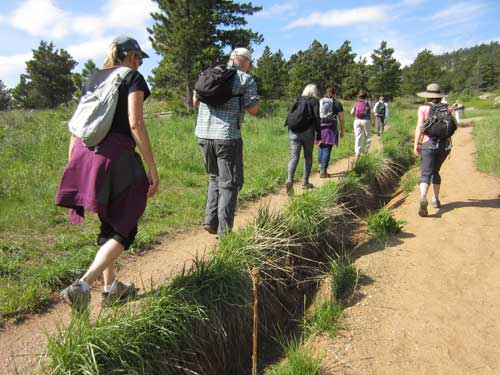

Golden Banner is also called False Lupine because the pea-shaped flowers are so similar. The word "banner" is the general name for the larger upper petals.

Native Americans consumed the seeds of the Blue Flax flower for their flavor and nutrients. The plant could also be used in making strong rope. Today, it is still cultivated for its linen fiber as well as flaxseed and linseed oils.


Known as the Boulder Raspberry or Rocky Mountain Raspberry, this member of the rose family was first collected by botanist Edwin James on an expedition in 1820 at the mouth of Boulder Canyon. Unlike so many other species of raspberry, this one has no thorns.

Approaching our second big hill

Every year, the OSMP (Open Space and Mountain Parks, run by the city of Boulder) closes certain areas from February 1st through July 31st to protect cliff-nesting raptors, such as golden eagles, peregrine falcons and prairie falcons.

The scenery changed dramatically as we entered the pine forest.



The Maiden (the 350-foot tall spire on the left) and Devil's Thumb (the spire with an elevation of 7,820 feet on the right) are both popular with today's rock climbers. In the early 1900's, a iron ladder was hammered into Devil's Thumb to make a 20-foot overhang doable for tourists. It has long since been removed.

A glimpse of the Flatirons... our end destination!

Tent caterpillars are in the lappet moth family. They build large silk sheets in the branches of trees where they lie together during molting (when they shed their outgrown skin). Some caterpillar species go through as many as five molts before becoming a pupa (the stage where it undergoes transformation into a moth). Its long spines provide protection.


Mouse-ear Chickweed was introduced from Europe but has naturalized here.

In North America there are over 250 Penstemon species (with 62 of them being native to Colorado). Unfortunately one must rely on more than just shape and color... especially since the color of even the same species can vary depending on soil, sunlight and amount of water.
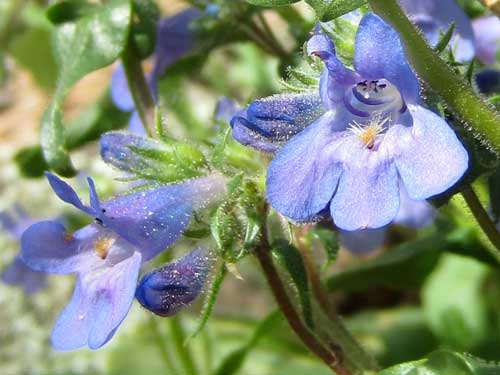
The word Penstemon comes from the Greek "pente" (five) and "stemon" (thread) after their five stamens.

Boisduval's Blue butterflies are often found near water. This one was trying to get a free ride on my ankle.
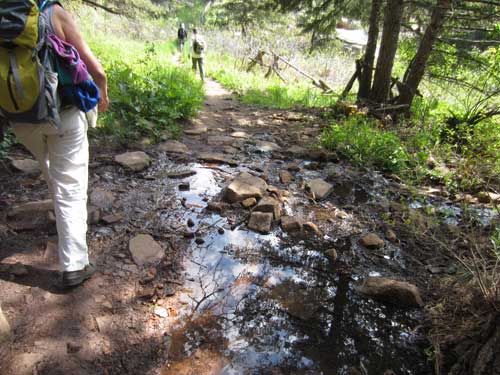
Oh look... water!


The Ponderosa Pine (or Western Yellow Pine) is one of the Southwest's tallest trees, growing to heights of over 200 feet. Named for its heavy (ponderous) wood, ponderosas are easily recognized by their tall, straight, thick trunks and scaled, rusty-orange bark that smells like butterscotch!


There are about 300 different species of larkspur. All parts of these plants are considered toxic to humans. Its common name comes from the flower resembling the foot of the lark.

Bright meadows stretch between the dark patches of trees.

The Wild Iris (also Western Blue Flag) is found where there is lots of moisture. The word 'iris' is Greek meaning rainbow.
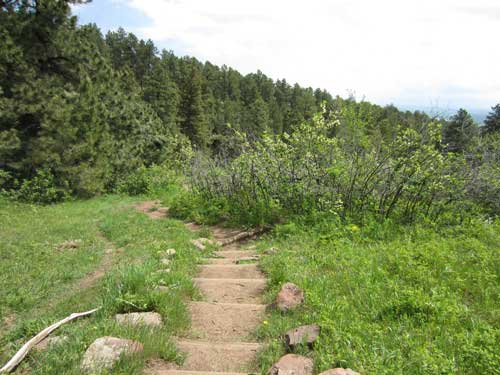

Crab apples are not native to Colorado. In the late 1800's, plant breeders started collecting various wild apple trees from around the world. The goal was to create small, colorful fruit that stayed on the tree until dry, thus reducing the amount of messy fruit litter. Ornamental value and disease resistance was more important than taste. And so, they are usually not considered edible (at least in raw form) by humans. Deer, however, apparently LOVE them.

Fendler’s Waterleaf (also Squaw Lettuce and White Cat's Breeches) prefers moist open places.

